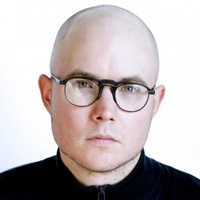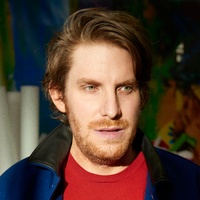On knowing when to pause
Prelude
The son of émigrés from Afghanistan and Poland, Lars Jan is a director, artist, writer, and activist known for visually striking, genre-bending performance and installation works exploring emerging technologies, live gatherings, and unclassifiable experience. In June 2017, his climate change-themed installation, Holoscenes, created a sensation in Times Square. As the winner of the 3rd Audemars Piguet Art Commission, Jan exhibited Slow-Moving Luminaries, a kinetic pavilion on an acre of beach during Art Basel Miami in December 2017. His staging of Joan Didion’s seminal essay “The White Album” was commissioned by and presented at BAM and will be performed at the Center for the Art of Performance at UCLA, in partnership with Center Theatre Group, April 5 - 7, 2019. Lars is represented by Charlie James Gallery and is on faculty at CalArts.
Conversation
On knowing when to pause
Visual artist and director Lars Jan on the value of taking a break, being the vehicle for larger ideas, and knowing when something is truly finished.
As told to Brandon Stosuy, 2798 words.
Tags: Art, Process, Time management, Production, Creative anxiety.
As an artist, you’ve worked with large-scale, multi-format video installations, aquatic ballets, massive architectural structures, and brought an ambitious adaptation of Joan Didion’s essay “The White Album” to the stage. There are many moving parts and tons of participants involved. When you finish a big project, how much downtime do you need to recover? Or, do you jump right back into something new to maintain momentum?
The moment I’m having right now feels different to me than any kind of pause that I’ve had up to this point. I’ve been overlapping projects, which are usually at varying states of development for a long time, definitely since grad school. I never really did pause. I would swing from the vine of one large project, leap midair, and just grab the other vine mid-flight and keep swinging.
With Slow Moving Luminaries, which was at Art Basel Miami in December 2017, and The White Album, which was at a few venues, culminating with BAM this past December, the last few years have been a particular blitz. Right now I’m actually giving myself the opportunity to not be committed to anything in the future, beyond just touring some existing work. I’m taking a hiatus.
Honestly, one of the things about this field is that I’m often committed maybe 18 months or two years in advance to a presentation. Working backwards from that deadline, because of the scale at which I work, has a way of determining everything up to the present moment. So I’m trying to take a pause. To me it actually feels like this is the end of a phase of my career. I don’t know if it’s going to end up actually looking like that, but I think metaphysically I feel that way.
I’ve been making things that I’ve wanted to make. I’ve been multi-tasking, and I’ve been over-extended for a long time. In that head space I haven’t had a lot of clarity. Recently, I’ve been asking myself: “Is this the trajectory that I want to stay on, or not? Is this of the kind of work that I want to be making, or are there other parts of this work that are more vital to me that I’d like to continue with? Are there things that I feel like I’m done with and I’d like to die off?”
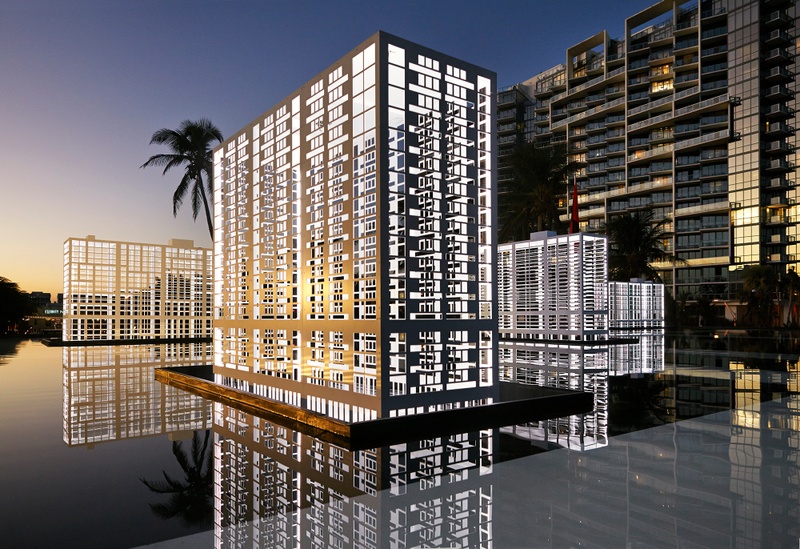
2017 Audemars Piguet. Lars Jan. Photo By Benoit Pailley.
It’s been a little more than a month since The White Album happened at BAM, which was in many ways a lifelong dream come true. I took some vacation with my family—my partner Mia is the lead in the performance and we have a six-year-old daughter, Esme. I guess I’m trying to be—I don’t know if the word is bored, but—I’m trying not to be particularly strategic for a moment. I’m just trying to daydream, let the gray matter recuperate, not make an extremely cogent plan, and just try to let there be space for boredom. Also, I just want to consume more art, watch movies, see performances, and read. I’m hanging out with my daughter a lot.
There’s no typical answer to that question, but it seems like a very important one to ask in terms of long-term health. One of the things I’m wondering is: “Am I just making too much work? Am I trying to make it too quickly?”
The issue is that I have way more ideas and things that I want to do than I can wrap my hands around. That’s just me realizing that a lot of these things that I really feel could be interesting to work on may never happen.
While you’re taking time off, and you’re in between projects, do you ever worry that you’ll end up making the time off itself into a project? Where you start thinking about, “All right, I’m going to go here and do this research?”
You know in those rodeos where there’s a bull and some sort of insane person, usually a dude, strapped onto it and holding on before the door swings open? I feel that way with projects. Right now I feel like there are half a dozen, or really maybe three, at the forefront of my mind that are just bursting to get out. They are all vying to be the one that I work on the most, or they’re talking to me and saying, “Work on all of us simultaneously.” I’m just working way harder than I ever have to keep them in this pen. I have yet to be able to actually get off the bull. I’m still on the bull, but I’m holding the door closed.
The next step for me would be get off the fucking bull. The extent to which I’m the servant of ideas that won’t let me go is kind of startling. It’s been happening for years now, but I’m only now really starting to feel the breakneck pace of it, and realize that, “Oh, man. I want to do this work and I want to serve these projects, but I also want to read books, and see friends, and hang out with my kid.” The projects don’t want to let me do that. They really don’t. They want me to serve them.
There are some people that need the momentum to keep going, but you were saying you still have the feeling of a bull behind the gate, even during this pause. Eventually the floodgate will open again.
I don’t know what happened. I’ve never done this. Since I’ve been an artist since I was about 20, and the thing that I’ve primarily tried to do is serve as a vehicle for the ideas that I have that come from wherever, and then to respond to the things that come up in collaboration, and discovery, and research.
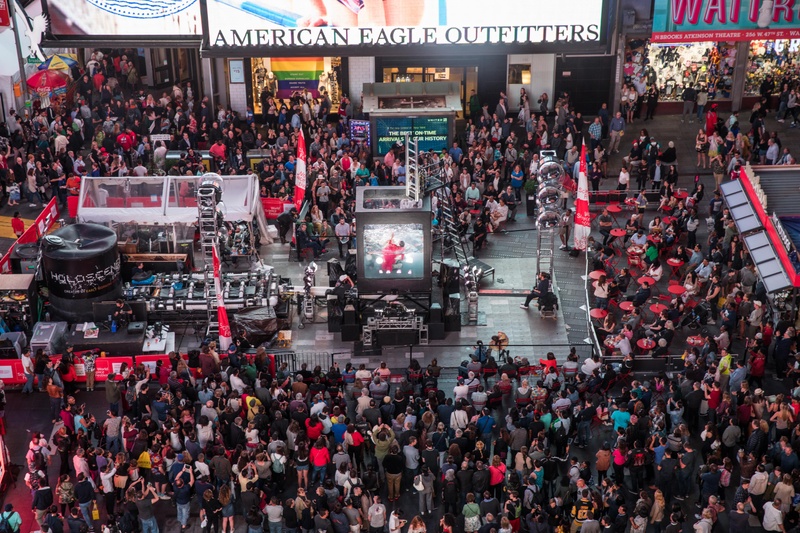
Holoscenes. Times Square. Photo by Max Gordon
I don’t think I was burned out, but there are only so many hours in the day. I realized that I wasn’t able to ever say yes to go see a performance. I was never having dinner with friends spontaneously. I was doing very little that was spontaneous. I know that those kinds of things feed me a lot. I don’t want to lose my connection to those things. I realized that I need to find a way to explore other parts of this creative practice, or narrow the bandwidth. I just want to see what it’s like. I want to make some kind of adjustment, and I don’t know what that adjustment is yet.
I may take a big step back and say, “Actually, I have a pretty good model.” Because there are a lot of things that are working.
Why do you think you needed the pause now?
My work is independent. That is, I don’t work for other people or direct-for-hire. Also, the nature of these projects is that I do many jobs on each, in addition to leading it artistically, particularly in terms of producing, logistics, and fundraising. It probably comes as no surprise, but managing a collaborative enterprise, the sheer number of stake-holders and social interactions, and the amount of personal risk and skin in the game, is depleting. That, and the big institutions, the temples of culture, are struggling, too. Generally, they can’t bail out the artists they’re involved with because they’re struggling themselves.
Has it ever come to mind to attempt smaller-scale projects?
I’ve made “smaller” projects all my life, but even works that have a small physical footprint or involve a fewer number of people tend to have a high level of complexity. The work is just never done. The amount of reading, and research, and conversations, and programming, and rehearsing… You could just go on infinitely. Work always has the potential to expand.
My education and my practice has actually always been about pushing myself in some sense. Like bodybuilding or something. I’ve been exercising for years in order to have the creative capacities to actually realize the large ideas that I’ve always had.
I recognize that I don’t have ideas that are Haikus. I love Haikus, but I tend to think more in terms of Russian novels. Maybe that’ll change, but for now that’s my tendency. I made a lot of works in basements, and garages, and one-performance-only-what-the-hell-are-we-doing-type events, with no rehearsal. I’ve done a lot of that, by necessity. I think I’ve gotten my craft to the point where I’m not thinking at that scale so much. But, yeah, I either have to do fewer projects, or the nature of them needs to change.
What draws you to collaboration?
I come from a performance background. Although I was a photographer first, and have been a visual artist for awhile, I have mostly been making work through the lens of performance. Performance is collaborative. One of the best things about performance is that it’s integrative and multidisciplinary; it’s a totally flexible format. To me, it’s just a big grab bag inclusive of any artistic form.
I’m interested in just moving energy through space with people over time. And I think more than performance per se, what I love are live audiences. The live audience for me is kind of a metaphysical counterpoint to the contemporary, digital, screen-oriented experience.
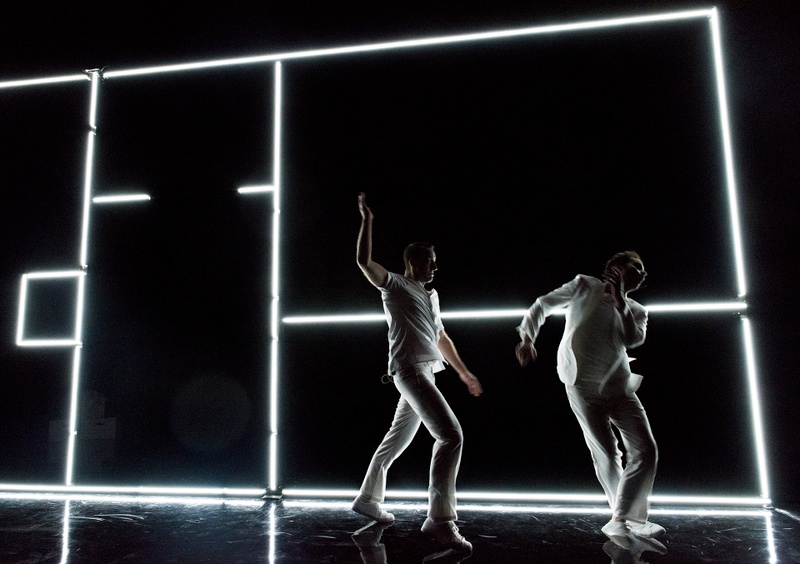
TIMe. Photo by Lars Jan.
One of my favorite things is to work with people who take an idea and do something much more interesting with it than I could ever have possibly imagined. I’m a bit of a writer, I’m a bit of a designer, I’m a director, but I try to have phenomenal artists working with me. That’s maybe my most important role as a director: assembling the most inspiring artists together around a shared focus.
As you mentioned, you have a wife and a daughter. Having a family can change how you make work. How has that shifted your practice?
Part of my passion around The White Album was feeling that my partner, Mia Barron, would be the perfect person to play the lead in the piece, which would mean that we could do a lot of the development, travel, and the touring as a family. That was a huge success of the show. Our collaboration was fantastic.
I’m not talking from a perspective of the quality of the art, although I thought her work was unquestionably magical, but more so in terms of our relationship. It was fantastic for our relationship and for our family. I don’t think that means, however, that we’re going to work on the next three things together. This was just a really perfect fit between the material, my skill set, what I wanted to do with it, and her skill set. In academic situations there’s this idea of a sabbatical. How does an independent artist imagine different kinds of sabbaticals, and how can I do that with my family?
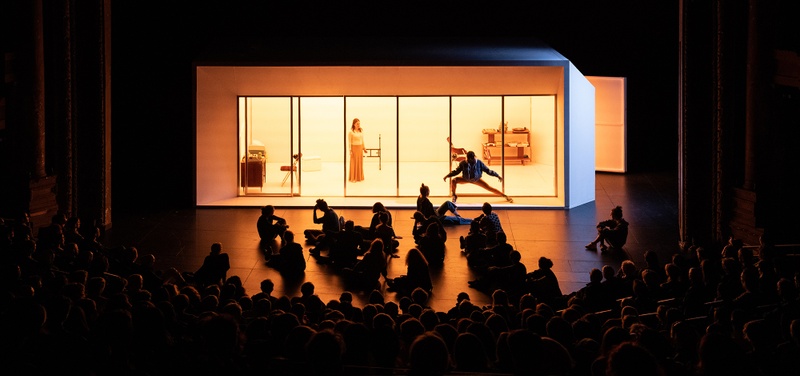
The White Album. BAM. Photo By Lars Jan.
You were saying that for a long time you saw yourself as the vehicle for the ideas. How do you know what form it’s going to take? Do you follow the idea until the form comes?
I see sections of the piece usually. I see it. For Slow Moving Luminaries I saw this space, and objects were moving through the space vertically. There were holes in the ceiling. I saw sections of the work. It wasn’t a performance. It was an environment. It was kind of a building, but it was also a kinetic sculpture. And so then the hard part is figuring out how to realize the concept in real space.
When you say you’re the vehicle for the idea, part of that is being open to change. Maybe sometimes the original vision shifts according to mitigating factors?
I think so. For example, there’s a project of mine called Holoscenes. I thought, “Oh, it’s a performance. Here’s this tank. It’s got glass on four sides. It will fill and drain with water. It’s going to be in a public space. This is what it’s going to be like.” And the performance of that concept—which took over three years to manifest—is very much like the idea I had from the very beginning. However, when I was in the early stages of development I couldn’t build that tank, so instead we had a cylindrical, non-transparent tank which we cut the top off of. It had two performers inside experimenting with choreography. Then it was: How fast can the water move? What’s our safety protocol? What does fabric look like in there, and props, and costumes? What kind of choreography is possible?

Holoscenes Cleaning. Toronto. Photo by LarsJan
In that beta phase I took pictures. I was watching rehearsals from the top of a scaffold looking down into the water, which is very different than looking at it from the side. I never considered that. I just made that prototype in order to achieve the final idea. But I loved what I was seeing, and so I made a video installation, and took photographs, and made some light boxes based on those that are very different from the finished Holoscenes work, that are from the development of the project. It was like walking into a cave and you’re like, “I’m going to go spelunking,” and then on the walls you see all of this amazing prehistoric art. Sometimes in the development of the work it’s just so exciting to just happen upon something. You think you’re headed somewhere else, and then on the way you’re like, “Oh, shit.”
How do you know when a project is done?
The White Album is a project that we performed in Pittsburgh. We did it at the Wexner in Ohio. We did it at BAM. We’re going to perform it at the Center for the Art of Performance in Los Angeles, which is co-represented by Center Theater Group. And I still don’t feel like the piece is totally finished. I don’t feel like I had nearly enough time to actually develop the work. I feel like I threaded a needle and got it to a certain point that I’m proud of, but I still haven’t had enough time to play with all of the components involved in the work to get them to harmonize in the way that I want.
We’re just going to continue to do that. But then it’s tough. There are a lot of things that are really working, but when you show it to the public, then you’ve got lots of feedback, lots of voices, audience feedback, reviews, and different people responding in drastically different ways. The variety of experiences of an artwork is so intense.
When I think the work is done, it’s much easier to listen to that stuff than when I don’t feel like the work is totally finished yet. It’s much more challenging for me to engage all of those perspectives. It’s a less peaceful process for me. When the work is done I love hearing all the different shit that people think—what they like, don’t like, whatever. I’m like, “Okay, that’s great. I feel like I made the thing that I wanted to make, and you feel that way. That’s really interesting.” But one of my goals, whatever is next, is that I want to feel like I have enough time to finish it before the so-called premiere. I haven’t felt that way in a little while.
Lars Jan recommends:
5 things that have helped me make performances and art, and which may (or may not) have application as advice
-
Tell people to come see what you’re doing, even if you’re not sure it will be good. Let them decide for themselves.
-
Learn how to make good pictures and videos of your own work.
-
Go see a lot. When you see something you like, let the people who made it know.
-
When you’re not sure which path to take, don’t take too much time to think about it. Pick one and go. If it’s the wrong one, start on the other.
-
Making work will make you better at making work, so make make make. Quick and dirty is the best way to start, and it might be the best way to end.
- Name
- Lars Jan
- Vocation
- Director, Visual artist, Writer, Activist
Some Things
Pagination
